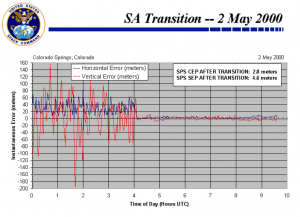If you wish to contribute or participate in the discussions about articles you are invited to contact the Editor
GPS Services: Difference between revisions
No edit summary |
Carlos.Lopez (talk | contribs) No edit summary |
||
| Line 1: | Line 1: | ||
{{Article Infobox2 | {{Article Infobox2 | ||
|Category=GPS | |Category=GPS | ||
| | |Editors=GMV A.D. | ||
|Level=Basic | |Level=Basic | ||
|YearOfPublication=2011 | |YearOfPublication=2011 | ||
|Title={{PAGENAME}} | |Title={{PAGENAME}} | ||
}} | }} | ||
Revision as of 10:13, 23 February 2012
| GPS | |
|---|---|
| Title | GPS Services |
| Edited by | GMV A.D. |
| Level | Basic |
| Year of Publication | 2011 |
GPS provides two different positioning services: the Precise Positioning Service (PPS) and the Standard Positioning Service (SPS).
Precise Positioning Service
As defined by the United States Government the GPS[1] Precise Positioning Service (PPS) is a positioning and timing service provided by way of authorized access to ranging signals broadcast at the GPS L1 and L2 frequencies. The L1 frequency, transmitted by all Navstar satellites, contains a coarse/acquisition (C/A) code ranging signal, with a navigation data message, that is available for peaceful civil, commercial, and scientific use; and a precision (P) code ranging signal with a navigation data message, that is reserved for authorized use. The P-code will normally be cryptographically altered to become the Y-code. The Y-code will not be available to users that do not have valid cryptographic keys. Navstar satellites also transmit a second P- or Y-(P(Y)-) code ranging signal with a navigation data message at the L2 frequency.
In order to restrict civilian user access to full system accuracy, the following protections were introduced:
- S/A or Selective Availability: intentional satellite clock degradation (process-δ) and ephemeris manipulation (process-ε). The effect on horizontal positioning implies going from about 10m (S/A=off) to 100m (S/A=on).[2] The process-δ acts directly over satellite clock fundamental frequency, which has a direct impact on pseudoranges to be calculated by user's receivers. The process-ε consists in truncating information related to the orbits.
USA President Bill Clinton ordered the termination of GPS Selective Availability on May 1st, 2000.[3] In September 2007, this decision was confirmed by the fact that the U.S. Government decided to procure the next generation of GPS satellites, GPS III, without the SA feature. This decision eliminates an important source of uncertainty that generated considerable concern among civil users.[4]
- A/S or Anti-Spooffing: it consists in P code encryption by combining it with a secret W code, resulting in the Y code, which is modulated over the two carriers L1 and L2. This serves the twofold purpose of protecting the code so that it can only be used by authorised receivers and avoiding adversaries to forge a misleading signal that could confuse military receivers. The use of A/S does not prevent civil users to take benefit from the C/A code.
Authorised users receive the corresponding encryption keys to access the PPS free from SA and A-S, and hence obtain the maximum accuracy from GPS. Should a PPS receiver have not been fed with valid keys, it could still behave as a SPS receiver.
The P(Y)-code, which is reserved for military use and authorised civilian users, is modulated over both carriers L1 and L2, and defines the Precise Positioning Service (PPS): it is reserved for military use and authorized civilian users. With a chipping-rate of 10Mbps and a wavelength of 29.31 m, the P(Y)-code is repeated every 38 weeks; a weekly portion, known as PRN, is assigned to each satellite.
Please refer to GPS Performances for more information about the performances provided by the PPS service.
Standard Positioning Service
As defined by the United States Government is[5] the GPS Standard Positioning Service (PPS) is a positioning and timing service provided by way of ranging signals broadcast at the GPS L1 frequency. The L1 frequency, transmitted by all satellites, contains a coarse/acquisition (C/A) code ranging signal, with a navigation data message, that is available for peaceful civil, commercial, and scientific use.
The Standard Positioning Service is based on the Coarse/Acquisition code (C/A(t)), which is modulated only on L1. It has a chipping-rate of 1.023 MHz, and contains 1 023 chips, so that the code is repeated every millisecond and each chip lasts about 1 µs, meaning a chip-width or wavelength of 293.1 metre.
Please refer to GPS Performances for more information about the performances provided by the SPS service.
Notes
References
- ^ Global Positioning System Precise Positioning Service Performance Standard
- ^ J. Sanz Subirana, JM. Juan Zornoza and M. Hernández-Pajares, Global Navigation Satellite Systems: Volume I: Fundamentals and Algorithms
- ^ Announcement of the cessation of GPS Selective Availability on May 1st, 2000
- ^ GPS III, without the SA feature
- ^ Global Positioning System Standard Positioning Service Performance Standard

